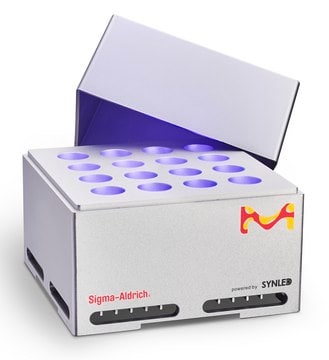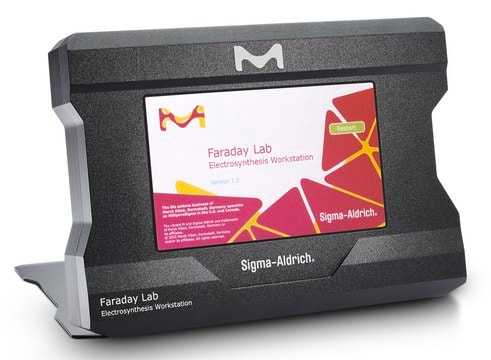Z744081
SynLED Parallel Photoreactor UV
with 365 nm LEDs
Synonym(s):
SynLEDphotoreactor, light source
About This Item
Recommended Products
AC/DC input
100 - 240 V AC, 50/60 Hz, universal plug set (included)
Quality Level
feature
capacity 16 vial(s)
parameter
365 nm spectral range
General description
This product is also available with 450 nm wavelength LEDs
Features and Benefits
- Bottom-lit LEDs (365 nm) across a 4x4 reaction block array provides consistent light intensity (320 lm) and angle (60°)
- New heat exchange system provides consistent temperature to each parallel reaction, while ensuring quieter operation
- Performance quartz LED cover protects LEDs from solvent and allows excellent light penetration
- Uses 1-2 dram scintillation vials or microwave vials (O.D. of 1.7 cm or less)
- Power supply is wall plug power supply including universal plug set
- Compatible with IKA magnetic stirrer with round plate (Z645052)
- Compatible with liquid scintillation vials (8 mL Wheaton, Z188719)
Certificates of Analysis (COA)
Search for Certificates of Analysis (COA) by entering the products Lot/Batch Number. Lot and Batch Numbers can be found on a product’s label following the words ‘Lot’ or ‘Batch’.
Already Own This Product?
Find documentation for the products that you have recently purchased in the Document Library.
Articles
The application of radical chemistry towards organic synthesis is well-developed and wide-reaching, though often hampered by a dependence on toxic radical initiators.
The application of radical chemistry towards organic synthesis is well-developed and wide-reaching, though often hampered by a dependence on toxic radical initiators.
The application of radical chemistry towards organic synthesis is well-developed and wide-reaching, though often hampered by a dependence on toxic radical initiators.
The application of radical chemistry towards organic synthesis is well-developed and wide-reaching, though often hampered by a dependence on toxic radical initiators.
Our team of scientists has experience in all areas of research including Life Science, Material Science, Chemical Synthesis, Chromatography, Analytical and many others.
Contact Technical Service







